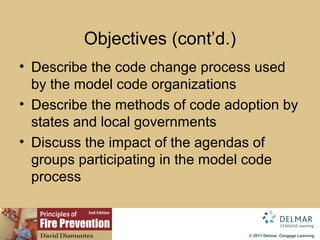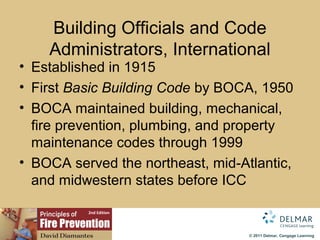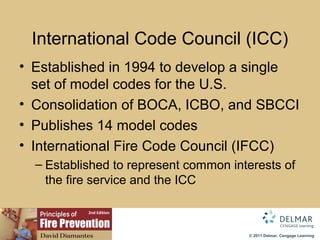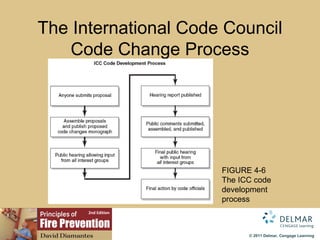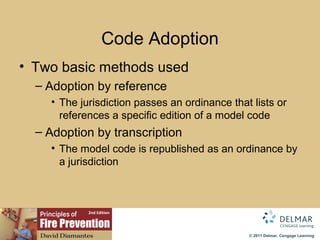Fire Prevention Chapter 4
- 1. Fire Prevention Through the Codes Process Chapter 4 2nd Edition © 2011 Delmar, Cengage Learning
- 2. Objectives Upon completion of this chapter, you will be able to: •Describe the origin of the model code system in the United States •List the major model code organizations and describe the evolution of model code organizations in the United States 2nd Edition © 2011 Delmar, Cengage Learning
- 3. Objectives (cont’d.) • Describe the code change process used by the model code organizations • Describe the methods of code adoption by states and local governments • Discuss the impact of the agendas of groups participating in the model code process 2nd Edition © 2011 Delmar, Cengage Learning
- 4. Model Codes • Codes: systematically arranged bodies of laws or rules • Codes tell us what to do or what not to do • Examples: United States Code, Code of Virginia, Code of the County of Fairfax • Model codes: technical rules made available for governments to accept – Adoption of the code 2nd Edition © 2011 Delmar, Cengage Learning
- 5. The Development of Model Codes • Fire insurance industry failed to self- regulate insurance rates/commissions – Started prevention through codes/standards • The NEC® may be the most universal model code • The NBFU published the National Building Code and National Fire Prevention Code through 1976 2nd Edition © 2011 Delmar, Cengage Learning
- 6. Model Code Organizations of the Twentieth Century • Many jurisdictions adopted NBFU codes • The NBFU was absorbed as part of Insurance Services Organization (ISO) • The NFPA grew into a 75,000-member international organization • Largest model code organizations consolidated into the International Code Council (ICC) 2nd Edition © 2011 Delmar, Cengage Learning
- 7. The Regional Model Code Organizations • System of regional codes, began in 1920s – Building code by the Pacific Building Officials Conference • Three regional code groups, 1950 • Three major regional codes evolved in the 20th century • National map of adopted codes resembled a puzzle: late 80s 2nd Edition © 2011 Delmar, Cengage Learning
- 8. Building Officials and Code Administrators, International • Established in 1915 • First Basic Building Code by BOCA, 1950 • BOCA maintained building, mechanical, fire prevention, plumbing, and property maintenance codes through 1999 • BOCA served the northeast, mid-Atlantic, and midwestern states before ICC 2nd Edition © 2011 Delmar, Cengage Learning
- 9. Southern Building Code Congress International • Established in 1940 • Published first edition of the Standard Building Code in 1945 • Published several codes through 1999 • Standard Fire Code: developed with the Southeastern/Southwestern Fire Chief’s Associations 2nd Edition © 2011 Delmar, Cengage Learning
- 10. International Conference of Building Officials • ICBO was established in 1921 as the Pacific Building Officials Conference • Uniform Building Code, first edition published in 1927 – Incorporated into the Department of Defense Military Handbook 1008 – Replaced by Unified Facilities Criteria, 2002 • Incorporated the International Building Code 2nd Edition © 2011 Delmar, Cengage Learning
- 11. International Code Council (ICC) • Established in 1994 to develop a single set of model codes for the U.S. • Consolidation of BOCA, ICBO, and SBCCI • Publishes 14 model codes • International Fire Code Council (IFCC) – Established to represent common interests of the fire service and the ICC 2nd Edition © 2011 Delmar, Cengage Learning
- 12. The National Fire Protection Association • Few comprehensive building regulations in effect in the 1800s • Fire underwriters formed NFPA in 1896 • Publishes almost 300 codes, standards, and recommended practices • NFPA’s NEC® may be the most widely used code in the U.S. • Triangle Shirtwaist fire: Life Safety Code® 2nd Edition © 2011 Delmar, Cengage Learning
- 13. Code Changes • Two major groups involved in the process – ICC – C3 group • NFPA, ASHRAE, IAPMO, and WFCA • Both groups use a consensus process to develop and maintain their documents – Disagree on what consensus really means 2nd Edition © 2011 Delmar, Cengage Learning
- 14. The International Code Council Code Change Process FIGURE 4-6 The ICC code development process 2nd Edition © 2011 Delmar, Cengage Learning
- 15. The NFPA Code Change Process FIGURE 4-8 NFPA uses a system of nine member categories to ensure that no group has undue influence within the code and standards development process 2nd Edition © 2011 Delmar, Cengage Learning
- 16. Fire Service Commitment • ICC voting procedures – Opportunity for full fire service participation – Obligation to present and future firefighters • Must exercise influence through groups – International Association of Fire Chiefs, the International Association of Fire Fighters (IAFF), and regional organizations 2nd Edition © 2011 Delmar, Cengage Learning
- 17. Code Adoption • Two basic methods used – Adoption by reference • The jurisdiction passes an ordinance that lists or references a specific edition of a model code – Adoption by transcription • The model code is republished as an ordinance by a jurisdiction 2nd Edition © 2011 Delmar, Cengage Learning
- 18. State and Local Adoption • Legal requirements to ensure adequate public notice – State minimum code that can be locally amended – State mini-maxi code with no option of local amendment • Favored by business interests/developers – Locally adopted code 2nd Edition © 2011 Delmar, Cengage Learning
- 19. What Codes Cannot Do • Cycle of catastrophe/public outcries of “there ought to be a law” will continue to exist • The largest fire prevention bureau cannot inspect every building every day 2nd Edition © 2011 Delmar, Cengage Learning
- 20. Summary • Organizations originally formed to reduce property loss and protect lives – Evolved to promote public safety • Major reorganization in community, 2003 – Three regional model code organizations voted to consolidate/form the ICC • Effective codes: adequate education, enforcement, and public cooperation 2nd Edition © 2011 Delmar, Cengage Learning



